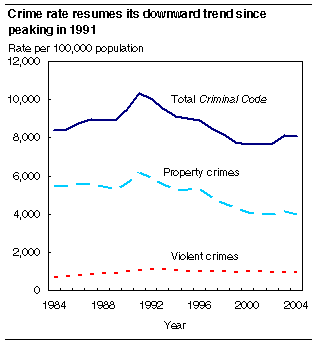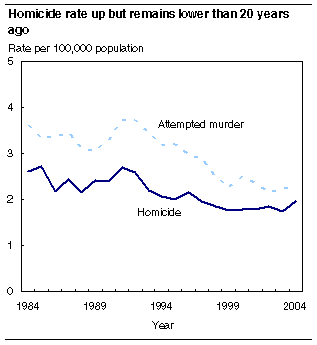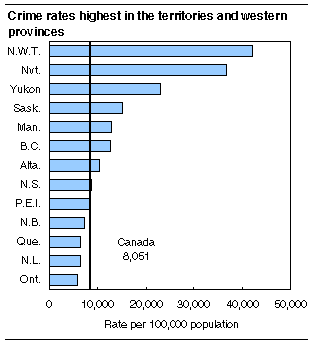
















 |
|
 |                |
Information identified as archived is provided for reference, research or recordkeeping purposes. It is not subject to the Government of Canada Web Standards and has not been altered or updated since it was archived. Please "contact us" to request a format other than those available.

|

Thursday, July 21, 2005 Crime statistics2004Canada's crime rate, based on data reported by police services, fell a marginal 1% last year. While the total violent crime rate declined, the national homicide rate increased 12%. Except for an increase in 2003, the crime rate has generally been falling since 1991 when it peaked. Police reported about 2.6 million offences in 2004, resulting in a crime rate that was 12% lower than a decade ago. Last year's decline was driven largely by a 5% decrease in Ontario, whose crime rate was the lowest in the country for the second year in a row. Most of this decline was due to large decreases in reported crime in the census metropolitan areas (CMAs) of Toronto, Hamilton, Ottawa and St. Catharines–Niagara. Prince Edward Island was the only other province to report a large decline in crime. Saskatchewan's crime rate, which experienced the largest increase of any province over the past decade, fell slightly in 2004. New Brunswick reported the largest increase, up 3%. 
Violent crime down but homicide rate upIn total, about 300,000 violent crimes were reported to police in 2004, the majority of which were common assault. The violent crime rate fell 2%, continuing a general decline since 1992. The violent crime rate was 10% lower than a decade earlier, but 35% higher than 20 years ago. Canada's homicide rate rose 12% in 2004 after hitting a 36-year low the year before. Police reported 622 victims of homicide, 73 more than last year. Alberta, British Columbia and Quebec accounted for most of this increase. The rate of 1.9 homicides for every 100,000 population was 5% lower than it was 10 years earlier.
The highest homicide rates were in the territories and western Canada. Provincially, Manitoba reported the highest rate (4.3) followed by Saskatchewan (3.9). The lowest rates were reported in Atlantic Canada. Among the nine largest census metropolitan areas (CMAs), Winnipeg had the highest homicide rate, followed by Edmonton and Vancouver. Quebec and Ottawa reported the lowest rates. Among the 18 smaller CMAs, Regina, Abbotsford and Saskatoon recorded the highest rates. Thunder Bay, Kingston, Sherbrooke and Greater Sudbury/Grand Sudbury all reported zero homicides in 2004. 
Robberies with a firearm continue to declineThe rate of robbery incidents fell 4% in 2004. Police reported more than 27,000 robberies, half of which were committed without a weapon of any kind. The rate of robberies committed with a firearm continued to decline, down 3% in 2004, accounting for one in seven robberies. The remaining 35% of robberies were committed with other weapons such as knives. Despite a national decline in robbery incidents, the Atlantic provinces experienced significant increases in 2004, ranging from 19% in Nova Scotia to almost 100% in Newfoundland and Labrador. However, robbery rates in the Atlantic provinces continue to be below the national rate. About 41% of all robberies occurred in commercial establishments, including 16% in convenience stores or gas stations and 5% in banks. The next most common locations were streets/sidewalks (30%), private residences (8%) parking lots (6%) and open areas (5%). Property crime resumes downward trendPolice reported nearly 1.3 million property crimes last year. The property crime rate dropped 3%, as most categories showed a decline. Property crime has generally been decreasing since 1991 with the exception of a notable increase in 2003. The rate of break-ins fell 4% to just under 275,000 and was 36% lower than a decade ago. More than one-half (56%) of break-ins were committed in residences, about one-third (31%) in businesses and the remaining 13% occurred in other areas such as garden sheds and schools. Prince Edward Island and Ontario reported the lowest provincial break-in rates, while the highest rates were in the West, particularly in Saskatchewan. Newfoundland and Labrador reported the largest increase in break-in rates, up 16%. Police reported nearly 170,000 stolen motor vehicles last year. The rate of vehicle theft fell 4%, and it has declined in all but two years since peaking in 1996. Cars accounted for just over half of all vehicle thefts while trucks, including vans and sport utility vehicles, comprised a further 34%. The rate of stolen cars dropped 4%, while truck thefts fell 2%. Ontario (-12%) and British Columbia (-6%) reported the largest declines in vehicle thefts, while Newfoundland and Labrador (+52%), Nova Scotia (+24%) and Manitoba (+23%) recorded the largest increases. Manitoba continued to have the highest rate among the provinces, primarily due to the high rate of thefts in Winnipeg. 
After large back-to-back increases in 2002 and 2003, the rate of growth in police-reported counterfeiting incidents slowed to 14%. In 2004, counterfeiting accounted for 6% of all criminal incidents, four times the proportion of only five years earlier. According to the Bank of Canada, $10 and $20 bills accounted for 87% of all counterfeit notes last year. Drug incidents resume upward trendThe rate of drug incidents increased 11% last year, following a 7% decline in 2003. Of the almost 100,000 drug incidents known to police in 2004, half were for possessing cannabis. The rate of cannabis possession incidents increased 15%. Cannabis cultivation, otherwise known as marijuana grow operations, has more than doubled over the past decade, from 3,400 incidents in 1994 to more than 8,000 incidents last year. The rate of cocaine-related incidents increased by 17% in 2004, numbering nearly 17,000. Youth crime downAbout 78,000 youth aged 12 to 17 were charged with a Criminal Code offence last year, while a further 101,000 were cleared by means other than laying a formal charge. Combined, this represents a 4% decline in the overall youth crime rate — a 6% drop in youths charged and a 2% drop in youths cleared by other means. The youth crime rate had generally been increasing between 1999 and 2003. The rate of violent crime among youth fell by 2%. Over the past decade, this rate has remained fairly stable, except for a large increase in 2000. Most categories of youth violent crime declined, including a 30% decrease in the youth homicide rate and a 2% drop in robbery. The youth property crime rate fell 8%. The majority of property offences declined, including an 11% drop in the motor vehicle theft rate and an 8% decline in the rate of break-ins. Available on CANSIM: tables 252-0013 and 252-0014. Definitions, data sources and methods: survey number 3302. The publication Juristat: Crime Statistics in Canada, 2004, Vol. 25, no. 5 (85-002-XIE, $9/$75; 85-002-XPE, $11/$100) is now available. For further information or to enquire about the concepts, methods or data quality of this release, contact Information and Client Services (1-800-387-2231; 613-951-9023), Canadian Centre for Justice Statistics.
| ||||||||||||||||||||||||||||||||||||||||||||||||||||||||||||||||||||||||||||||||||||||||||||||||||||||||||||||||||||||||||||||||||||||||||||||||||||||||||||||||||||||||||||||||||||||||||||||||||||||||||||||||||||||||||||||||||||||||||||||||||||||||||||||||||||||||||||||||||||||||||||||||||||||||||||||||||||||||||||||||||||||||||||||||||||||||||||||||||||||||||||||||||||||||||||||||||||||||||||||||||||||||||||||||||||||||||||||||||||||||||||||||||||||||||||||||||||||||||||||||||||||||||||||||||||||||||||||||||||||||||||||||||||||||||||||||||||||||||||||||||||||||||||||||
|
|
|